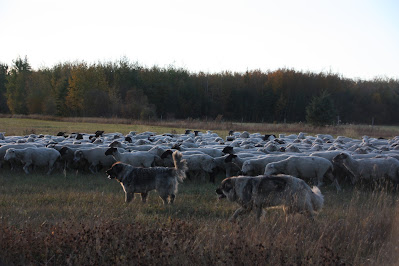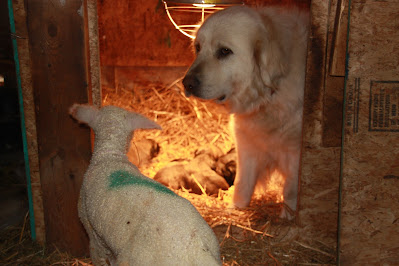 |
This llama is displaying its unhappiness with our presences close to the fence of the sheep paddock. It is highly territorial and likes to stay between the perceived danger and the sheep. |
Louise Liebenberg 2022, written for The Shepherds Magazine
This is the second part of a small mini-series on other animals that can be
used to protect sheep from predators. The two most common “go to” guard animals,
other than livestock guardian dogs (LGD) are donkeys and llamas. This article will take a closer look at llamas.
There have been very few studies done on the use and effectiveness of guard
llamas, most of the articles and stories are anecdotal rather than hardcore
scientific research. In the 1990’s, Iowa State University did a telephone
survey to try and look a little closer at the effectiveness of using guard
llamas to protect sheep from predation.
For those who do not know llamas are camelids that originate
in South America and were domesticated for meat, fibre and utilised as pack
animals. Llamas should not be confused with their smaller counterpart the
alpaca. Alpacas should not really be used as guard animals due to their small
size, in areas with apex predators. Alpaca’s might be a good option for smaller
animals such as racoons, or foxes and for guarding smaller livestock but will
not be able to contend with grizzly bears or wolves.
Llama’s can weigh in the region of 250 lbs making them a fairly large sized
animal, while alpacas are in the 120-140 lbs range.
Due to their height, they certainly have an advantage that they can see further
than sheep can. They behave like sentry animals, and due to their alertness are
quick to warn for any dangers, they can make a variation of vocalizations, which
the sheep soon learn to respond to. Llamas can run, stomp, strike, kick, and
spit at predators. Often it is also the larger size that can dissuade
predators. Llamas can be quite
territorial about their pasture even occasionally being aggressive towards
people who approach the pasture.
Llamas are generally quite effective against smaller
predators such as coyotes, foxes, skunks, and racoons. They do however prefer
open, flatter spaces than wooded hilly areas, it has been reported that llamas
will not really enter forested or bushy areas. Llamas seem to perform best on
pastures smaller than 250-300 acres and up to about 300 ewes.
Llamas who are well bonded to the sheep are the most effective at their job. Similarly
with livestock guardian dogs and donkeys, it is imperative that the sheep and
the guard animal form a bond. Without this bond, no other species will feel the
need to protect the sheep from predators. It is also generally advised that
just a single llama should be placed with the ewes, so that it remains bonded
to the sheep rather than forming an attachment to another llama and forgetting
about the sheep. There is a bit of an
adjustment time for the sheep and llamas to get to know each other but when
raised from a young age with sheep, this period can be a matter of a few weeks
before both species are comfortable with each other. As intact male llamas can
become quite aggressive towards the sheep and might try to breed/mount the
ewes, it is always advisable to geld the male llamas. Female llama are also used
successfully. In the 1990 study, most producers preferred using gelded males.
Keeping llamas requires similar management to sheep. They
graze alongside the sheep and when the flock needs deworming, hoof trimming and
shearing, so does the llama. It is advisable to halter break the llama so that
it can be easily removed from the flock when routine work gets done, or for
ease at shearing time.
Here are some interesting results from the Iowa State university study
regarding the use and effectiveness if guard llamas:
Most guard llama’s were gelded males.
80% of llamas were rated as “effective or effective at reducing losses to
predators”.
88% of owners were either “satisfied or very satisfied” with
their llama program.
Over half the producers felt that llamas provided some savings by reducing
predation.
75% of the llamas were reported not to negatively affect the sheep they were
protecting.
Predation fell from 21% to 7% after a
guard llama was introduced to the flock.
Sheep losses before llamas were noted to be around 11% and after the llama was
introduced losses declined to about 1%. One does need to bear in mind that all
producers continued to use alternate methods to reduce predation in conjunction
with the llama (fencing, shooting, trapping, poison etc.)
predation increased when multiple llamas were introduced to the flock.
Llamas have been observed in South America aggressively chasing away foxes but
did run away when mountain lions appeared.
llamas are found to be less effective when it comes to packs of coyotes or
dogs. One llama is not able to contend with multiple predators at the same
time. One should remember that llamas are also prey animals to large predators,
and this could put the llama in serious jeopardy.
As with all guard animals there are always pros and cons, here are a few
considerations:
Due to the innate aggression towards smaller canine, it may be difficult to use
herding and guard dogs with a llama in the pasture.
Although easy keepers, they do require some specific management, it can be hard
to find someone who will come and shear a llama, they require more copper than
sheep do and often do not utilise hard salt or mineral blocks and require these
in a “loose” form.
Llamas vocalise fairly softly when there is danger, usually if a guardian dog
barks the shepherd or rancher can hear by the barking that predators may be
close by.
A barking dog can also provide some protection to the farm, something that a
llama does not do.
I think on small homesteads, or farms with neighbours close by,
a guard llama might be a better option than a guard dogs, particularly on
homesteads where the predators are smaller and the number of animals requiring
protection are less. Llamas will not keep the neighbours awake from barking,
they integrate rapidly in a small sheep or goat herd, they can provide more
fiber options on fiber-based homesteads, they can become well socialised and
tame and can be trained as pack animals and in some areas even hiking
companions. Llamas do not dig out or
actively try to escape fences like guard dogs sometimes do. Llamas can live for
20-25 years providing many years of protection to the sheep flock. In some
cattle operations guard llamas are used to help protect newborn calves from coyotes.
Recognizing that llamas are also prey animals and understanding their
limitations, I do think llamas are a good option for many smaller pasture-based
operations. The provide another layer of protection to the flock. Llamas can
become very devoted to their flock and the sheep really seek out the
companionship of the taller and bigger animal.
This alpaca was added to a group of young ram lambs to provide an
additional layer of protection for the flock. This operation also uses guard
donkeys with their ewes.





























